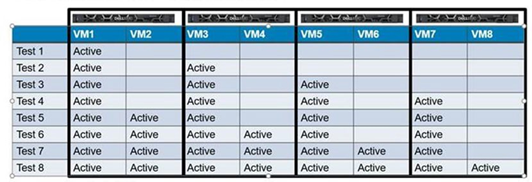Home > Integrated Products > vSAN Ready Nodes > White Papers > SQL Server 2019 on PowerEdge R640 vSAN Ready Nodes: Using VMware vSAN 7 and Red Hat Enterprise Linux 8 > Test methodology
Test methodology
-
Configuration overview
We tested the scalability of eight VMs across the four-node vSAN Ready Node cluster. We tested one VM, and with each iteration of the test, we added a VM in the following manner:

Figure 5. Test iteration layout
Each VM was configured with the following parameters:
Table 3. VM configuring parameters
Component
Description
vCPU count
4
Memory for VM
320 GB (operating system)
Memory for SQL Server
256 GB (SQL Server)
Filesystem on Red Hat Enterprise Linux
XFS
Database size
1 TB TPC-C
Controller used
VMware PVSCSI controller
Test methodology and goals
HammerDB is an open-source tool that is used for benchmarking and load testing different databases including SQL Server. We used the TPC-C benchmark, which is a widely accepted OLTP benchmark. A scale factor of 10,000 warehouses resulted in a SQL Server database approximately 1 TB in size.
The following table summarizes the test parameters:
Table 4. Testing parameters
Parameter
Value
Number of warehouses
10,000
Transactions per user
1,000,000
Keying and Thinking time
Enabled for 10% of all transactions
Ramp up
10 minutes
Test duration
20 minutes
All warehouses
Enabled
Virtual users
400
Iterations
100
Keying and Thinking time was enabled for our testing. However, using the HammerDB tool, only 10 percent of the transactions were subjected to a total Keying and Thinking time of 1 second, rather than the default high values, ranging between 20 to 40 seconds. These values were chosen to simulate a high-stress workload.
The goal of the testing was to simulate high-stress OLTP SQL Server database loads that stressed the vCPU to within 50 to 60 percent utilization. This test was monitored and verified using dstat captures for the VMs. These VMs simulate the behavior of eight production SQL Server VMs in an enterprise.
